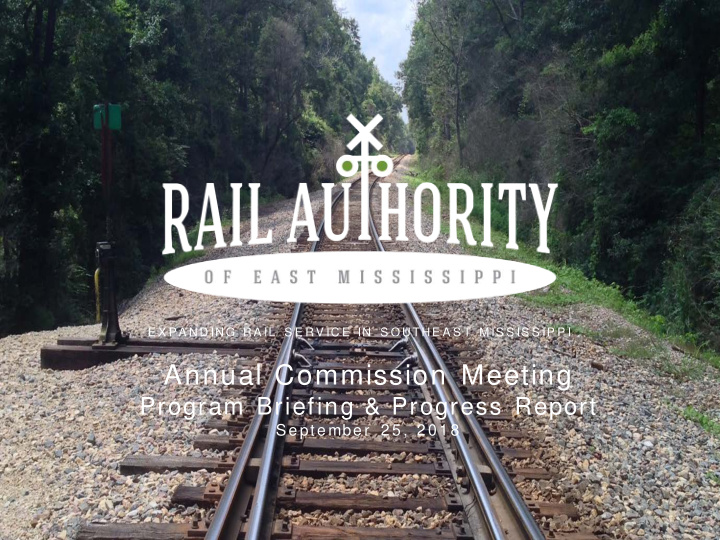



E X PA N D IN G R A IL S E R V IC E IN S O U TH E A S T M IS S IS S IP P I Annual Commission Meeting Program Briefing & Progress Report Se pt e mbe r 2 5 , 2 0 1 8
Rail Authority of East Mississippi Mission Purpose Goal Implementation of the Support and attract Establish continuous rail East Mississippi economic growth and service from Meridian to Intermodal Rail Corridor development Pascagoula by opportunities in southeast connecting Waynesboro Mississippi to Evanston
Missing Link “To be an economically viable region, we have to have access to rail transportation . . . it’s crucial to Mississippi that we see the proposal to establish rail service between Waynesboro and Lucedalebecome a reality.” The Late, Honorable Gil Carmichael, Administrator, Federal Railroad Administration, 1989-1993 (The Wayne County News, Feb. 24, 2010)
East MS Intermodal Rail Corridor 19 miles along former GM&O to Stateline 37 miles on new location to Lucedale Links four Class I railroads KCS / NS (Meridian) CN (Lucedale) CSX (Pascagoula) Crosses three interstate highways (I- 20, I-59, I-10) and three 4-lane U.S. Highways (45, 98, 90) Service to three Gulf of Mexico ports (Gulfport, Pascagoula, Mobile)
Where We Are Analysis of Engineering and Construction Feasibility – Complete Identify Alternative Alignments Establish Design Criteria Prepare Detailed Opinions of Cost Identify Potential Constraints Analysis of Impacts to Local and Regional Economies & Markets – Complete
Where We Are National Environmental Policy Act (NEPA) Reasonable Alternatives Archaeological/Cultural Resources – Complete Wetlands Analysis – Complete Threatened & Endangered Species – Complete Noise & Vibration – Complete Additional Impacts to Human and Natural Environments – Ongoing Preparation of Environmental Assessment Report & Coordination with Federal Rail Administration – Middle of 2019
Where We Are Continued Pursuit of Available Funding Sources MDOT Intermodal Grants Program – April 2018 USDOT – BUILD Grant Program (formerly TIGER) – July 2018 State of Mississippi – Bond Appropriations USDOT – CRISI Grant Program – October 12, 2018
What We’ve Found Since the 1983 GM&O closure, unemployment in Wayne, Greene, and George Counties has risen from 4.8% (1970) to an average of 9.1% (1990-2016). It is projected that implementation of the EMIR would bring back 3,351 total jobs over a 30-year period, bringing unemployment back down within the state balance. Reestablishment of rail service in the Corridor is projected to enable the region to recapture its fair share of rail dependent industries. Fiscal impacts (wages and associated federal and state taxes) within Wayne, Greene, and George Counties are projected over 30 years to exceed $1.5 billion . The rail industry in general is substantial in size, growing, and supported by long-term trends. Increasing transportation costs and demand for fuel efficiency are driving rail-dependent companies to shift more of their business to rail.
A case study of the economic impact short line railroads have had across the state of Louisiana are significant and relevant to Southeastern M Mississippi Employment The American Association of Railroads estimates that in terms of overall employment impact, each short line rail job in the local economy supports approximately 4.5 other jobs . Since 331 are directly employed by short lines, short line rail supports approximately 1,490 other jobs in the state economy for a combined total employment impact of 1,821 jobs Spending The American Short Line and Regional Rail Association estimate annual earnings of $89,000 per mile of functional track, representing approximately $44.5 million in annual revenues in LA. This figure, less estimated wages paid of $22.2 million and maintenance expenses of $1.95 million , leaves approximately $20.35 million to be used for other expenses Highway Repair In 2010, the American Short Line and Regional Railroad Association estimated that short line railroads in Louisiana facilitated the transportation of approximately 472,000 truckloads of freight, preventing approximately $21 million in pavement damage that would have been the responsibility of government to repair *Source: National Center for Intermodal Transportation for Economic Competitiveness “Economic Impact and Analysis of Short Line Railroads”
“RAEM Market Feasibility and Economic Impact Study”, February 2018 (IXL Center) Lost Impacts w/out Projected Impacts Rail w/Rail Type of Impact 1985-2015 2023-2053 Ave. Annual Carloads N/A 18,723 Total Carloads N/A 561,697 Additional Direct Jobs (1,941) 664 Additional Indirect & Induced Jobs (3,575) 1,888 Total Jobs (5,516) 2,552 Wages ($2,406,555,000) $5,068,284,000 Federal Taxes ($601,639,000) $1,267,070,000 State Taxes ($120,329,000) $253,415,000 Total Fiscal Impacts ($721,968,000) $1,520,485,000
Submit CRISI Program Grant Application to FRA Complete Conduct Public Environmental Review and Assessments Comment Meetings Complete Coordinate with Preliminary Design, Federal Rail ROW and Administration Permitting for NEPA Requirements Compliance Develop Prepare Long Institutional Term Funding Where Strategy for Strategy We’re Implementation of EMIRC Headed
Recommend
More recommend